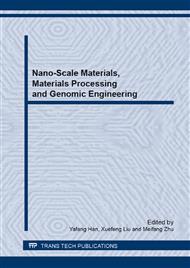p.224
p.230
p.235
p.240
p.249
p.255
p.259
p.262
p.270
Study on Preparation and Property of High Thermal Oxidation Stability PPS/SiO2 Fiber
Abstract:
PPS/SiO2 composite was studied to enhance the thermal oxidation stability of PPS. In order to improve the dispersity of SiO2 in PPS matrix, the SiO2 was modified by silane coupling agent, KH-570. The fractured surface morphologies, thermal properties and rheological property of PPS/SiO2 composite were researched. The high thermal oxidation stability PPS/SiO2 fibers were prepared by melt spinning. The thermal ageing treatment was carried out, and the strength and retention strength, before and after ageing treatment, of two kinds of fibers (PPS fibers and PPS/SiO2 fibers) were compared. The results of SEM showed the good dispersity of the modified SiO2 in PPS matrix. After adding modified SiO2, the initial decomposition temperature increased. At the same time, the fiber strength and retention strength were improved, which can be found by comparing. Compared with pure PPS, after adding 1.0 wt%, which was proved to be the optimum dosage by the research, modified SiO2 into PPS, the initial decomposition temperature was increased by 15.3°C, the retention strength was increased from 60.3% to 85.1% after ageing treat.
Info:
Periodical:
Pages:
249-254
Citation:
Online since:
April 2014
Authors:
Price:
Сopyright:
© 2014 Trans Tech Publications Ltd. All Rights Reserved
Share:
Citation:


